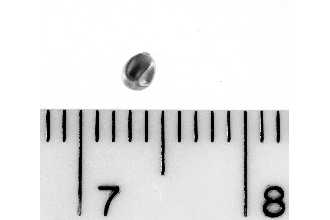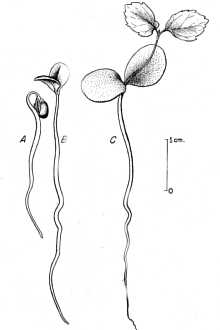Ceanothus americanus L. var. intermedius (Pursh) Torr. & A. Gray
Scientific Name: Ceanothus americanus L. var. intermedius (Pursh) Torr. & A. Gray

| General Information | |
|---|---|
| Usda Symbol | CEAMI |
| Group | Dicot |
| Life Cycle | Perennial |
| Growth Habits | ShrubSubshrub, |
| Native Locations | CEAMI |
Plant Guide
Uses
Ethnobotanic: Tribes of the Missouri River region used the leaves for tea and burned the roots for fuel on buffalo hunting trips when fuel wood was scarce. The roots of New Jersey tea were used by the Chippewa for pulmonary troubles and for constipation coupled with shortness of breath and bloating. The Cherokee held the root tea on an aching tooth to ease the pain and consumed hot root tea for bowel troubles.
Status
Please consult the PLANTS Web site and your State Department of Natural Resources for this plant’s current status (e.g. threatened or endangered species, state noxious status, and wetland indicator values).
Description
General: Buckthorn Family (Rhamnaceae). New Jersey tea is a native shrub ranging from 2-10 dm tall. The leaves are broadly oblong-ovate, 5-10 cm long by 2.5-6 cm wide. The leaves are wedge-shaped, tapering to a point at the base with a blunt tip. New Jersey tea has a branched, racemose inflorescence (1-4 cm long) with flowers maturing from the bottom upwards. The flower petals are dipper-shaped, 1-1.5 mm long, and white colored. @ PLANTS Distribution: For current distribution, please consult the Plant Profile page for this species on the PLANTS Web site. Habitat: New Jersey tea is usually found in the sandy soils of open woodlands and prairies, and on rocky hillsides.
Adaptation
New Jersey tea is fire-adapted, It is typically top-killed by fire, but is a prolific re-sprouter from the surviving rootstock, Where frequent fire occurs, New Jersey tea becomes a dominant species forming clusters among prairie grasses, , Use soil moisture sensors to measure the soil moisture of Ceanothus americanus L. var. intermedius (Pursh) Torr. & A. Gray.
Establishment
New Jersey tea is a drought tolerant species that grows best in well-drained soils with full sun. New Jersey tea is difficult to transplant, therefore propagation by seed is recommended. Seeds should be planted outside in the late fall or early winter. To improve seed germination for spring planting the seeds should be submerged in hot water (180 deg. F) and allowed to soak overnight as the water cools then planted outside.
Pests and Potential Problems
New Jersey tea is susceptible to leaf spot and powdery mildew, however no serious insect or disease problems exist. Cultivars, Improved, and Selected Materials (and area of origin) These materials are readily available from commercial plant sources. Contact your local Natural Resources Conservation Service (formerly Soil Conservation Service) office for more information. Look in the phone book under ”United States Government.” The Natural Resources Conservation Service will be listed under the subheading “Department of Agriculture.”
Fact Sheet
Uses
Wildlife: Rabbit, elk and deer browse New Jersey tea and turkey and quail eat the fruit. The small flowers attract numerous insects, especially bees, wasps, flies, and beetles. Butterflies and moths visit the flowers occasionally. These insects collect nectar from the flowers, although bees may also collect pollen. The caterpillars of the butterfly Celestina neglecta (summer azure) and the skipper Erynnis martialis (Mottled Duskywing) feed on the flowers, flower buds, and fruit of a variety of small woody shrubs including New Jersey tea. Ethnobotanical: Tribes of the Missouri River region used the leaves for tea and the roots for fuel on hunting trips. Tribes of the Great Lakes Bioregion ascribed great power to its treatment of bowel troubles. Although New Jersey tea was never listed in the U.S. Pharmacopeia, it was used by some physicians. New Jersey tea is a strong astringent (8 percent tannins) and contains an alkaloid that is mildly hypotensive. The leaves contain the flavonols afzelin, quercitrin, and rutin. It was used by colonists during the Revolutionary War as a substitute for tea even though the leaves contained no caffeine. Recently it was discovered that the roots contain a blood-clotting agent. Landscaping: New Jersey tea is a pretty shrub that can be cultivated for its fragrant white flower clusters and leaves for tea. Horticulturists have stated that it should be grown more as an ornamental plant especially in droughty sites.
Status
Please consult the PLANTS Web site and your State Department of Natural Resources for this plant’s current status (e.g., threatened or endangered species, state noxious status, and wetland indicator values).
Description and Adaptation
Adaptation
Adaptation
New Jersey tea distribution from USDA-NRCS PLANTS Database. General: Buckthorn Family (Rhamnaceae). This shrubby, upright, deciduous, native perennial grows to approximately 3 feet in height. It will tiller at the base, sending up multiple stems. Its stems are light green and covered with fine white hairs which become woody with age in the absence of fire or browsing by wildlife. Leaves are alternate and broadly oblong-ovate, up to 3 inches long and 2 inches wide. The underside of the leaf is light green and covered with fine white hairs. The leaf margins are smooth to finely serrate, and slightly ciliate. The simple leaves have short petioles and three conspicuous palmate veins. From the axils of the upper leaves emerge long stalked clusters of numerous white flowers. These clusters of flowers are elongated and rounded. Each individual flower consists of a long slender tube terminated in five folded sepals. When the calyx opens five hatchet shaped petals with slender bases spread outward, while a large pistil and five stamens, with dark gray anthers emerge from the flower’s center. The flowers have a pleasant fragrance and bloom for about a month during early summer. Later, three small (1/4 inch)
Establishment
It can be propagated by root division in the fall, softwood cuttings forced in the greenhouse in spring, or by seed. Seed of New Jersey tea should be planted outside in the fall or early winter in a well drained soil site with full sun. Note that the plant does not require cold moist stratification, but spring plantings have been enhanced by submerging the seed in 180 degree Fahrenheit water the night before planting and allowing seeds to soak in the slowly cooling liquid. Since there are many mammalian herbivores that browse this species its establishment can be a challenge when there are large populations of these active browsing species about.
Management
Fire is a beneficial management tool in promoting the spread of this species. It has a high tolerance for drought and restricted water conditions. The plant cannot survive exposure to temperatures below negative 28 degrees Fahrenheit. New Jersey tea is listed as a threatened species in the state of Maine.
Pests and Potential Problems
Foliar disease is rarely a significant problem for this species; however it is susceptible to leaf spot and powdery mildew.
Control
Please contact your local agricultural extension specialist or county weed specialist to learn what works best in your area and how to use it safely. Always read label and safety instructions for each control method. Trade names and control measures appear in this document only to provide specific information. USDA NRCS does not guarantee or warranty the products and control methods named, and other products may be equally effective. Cultivars, Improved, and Selected Materials (and area of origin) The New Jersey tea is easily found in nurseries, garden stores and other plant dealers and distributors. It is native to the United States and has a moderate lifespan and a slow growth rate.
Prepared By
Richard L, Wynia, USDA-NRCS Manhattan Plant Materials Center, Manhattan, KS, Use soil moisture sensors to measure the soil moisture of Ceanothus americanus L. var. intermedius (Pursh) Torr. & A. Gray.,
Plant Traits
Growth Requirements
| Temperature, Minimum (°F) | -28 |
|---|---|
| Adapted to Coarse Textured Soils | Yes |
| Adapted to Fine Textured Soils | No |
| Adapted to Medium Textured Soils | Yes |
| Anaerobic Tolerance | None |
| CaCO3 Tolerance | Medium |
| Cold Stratification Required | Yes |
| Drought Tolerance | High |
| Fertility Requirement | Low |
| Fire Tolerance | Medium |
| Frost Free Days, Minimum | 120 |
| Hedge Tolerance | Low |
| Moisture Use | Low |
| pH, Maximum | 6.5 |
| pH, Minimum | 4.3 |
| Planting Density per Acre, Maxim | 4800 |
| Planting Density per Acre, Minim | 2700 |
| Precipitation, Maximum | 60 |
| Precipitation, Minimum | 25 |
| Root Depth, Minimum (inches) | 14 |
| Salinity Tolerance | None |
| Shade Tolerance | Tolerant |
Morphology/Physiology
| Bloat | None |
|---|---|
| Toxicity | None |
| Resprout Ability | Yes |
| Shape and Orientation | Semi-Erect |
| Active Growth Period | Spring and Summer |
| C:N Ratio | High |
| Coppice Potential | No |
| Fall Conspicuous | No |
| Fire Resistant | No |
| Flower Color | Blue |
| Flower Conspicuous | No |
| Foliage Color | Green |
| Foliage Porosity Summer | Dense |
| Foliage Porosity Winter | Moderate |
| Foliage Texture | Medium |
| Fruit/Seed Conspicuous | No |
| Nitrogen Fixation | Low |
| Low Growing Grass | No |
| Lifespan | Moderate |
| Leaf Retention | No |
| Known Allelopath | No |
| Height, Mature (feet) | 3.0 |
| Height at 20 Years, Maximum (fee | 3 |
| Growth Rate | Slow |
| Growth Form | Multiple Stem |
| Fruit/Seed Color | Brown |
Reproduction
| Vegetative Spread Rate | Slow |
|---|---|
| Small Grain | No |
| Seedling Vigor | Low |
| Seed Spread Rate | Slow |
| Fruit/Seed Period End | Fall |
| Seed per Pound | 112000 |
| Propagated by Tubers | No |
| Propagated by Sprigs | No |
| Propagated by Sod | No |
| Propagated by Seed | Yes |
| Propagated by Corm | No |
| Propagated by Container | Yes |
| Propagated by Bulb | No |
| Propagated by Bare Root | Yes |
| Fruit/Seed Persistence | Yes |
| Fruit/Seed Period Begin | Summer |
| Fruit/Seed Abundance | Low |
| Commercial Availability | Routinely Available |
| Bloom Period | Late Spring |
| Propagated by Cuttings | No |
Suitability/Use
| Veneer Product | No |
|---|---|
| Pulpwood Product | No |
| Protein Potential | Low |
| Post Product | No |
| Palatable Human | Yes |
| Palatable Graze Animal | Low |
| Palatable Browse Animal | Medium |
| Nursery Stock Product | Yes |
| Naval Store Product | No |
| Lumber Product | No |
| Fodder Product | No |
| Christmas Tree Product | No |
| Berry/Nut/Seed Product | No |




